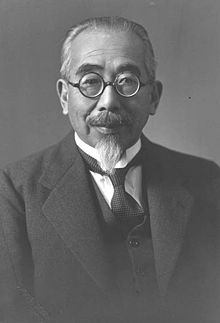This is an old revision of this page, as edited by Bbolman (talk | contribs) at 18:23, 21 January 2025 (Creation of page, inclusion of basic information. Notes may need tweaking). The present address (URL) is a permanent link to this revision, which may differ significantly from the current revision.
Revision as of 18:23, 21 January 2025 by Bbolman (talk | contribs) (Creation of page, inclusion of basic information. Notes may need tweaking)(diff) ← Previous revision | Latest revision (diff) | Newer revision → (diff)Kingo Miyabe (April 27, 1860 - March 16, 1951) was an influential Japanese botanist and mycologist. He received the Order of Cultural Merit in 1946 and was an honorary international member of the American Academy of Arts and Sciences.

Life
Miyabe was a graduate of the second class of students at Sapporo Agricultural College. In 1882, he was a founding member of the Tokyo Botanical Society. As part of broader efforts to develop expertise in scientific botany in Japan, Miyabe traveled to Harvard University to study with Asa Gray and William G. Farlow. Miyabe returned to Japan in 1889 as a professor at Sapporo Agricultural College.
Miyabe maintained active correspondence with botanists around the world, including Curtis Gates Lloyd. He is best known for a series of floristic studies of Japan, including The Flora of the Kurile Islands (1890), The Laminariaceae of Hokkaido (1902), Plants in Sakhalin (1915, co-authored with Tsutome Miyake), Flora of Hokkaido and Saghalien (co-authored with Yushun Kudo), and Icones of the essential forest trees of Hokkaido (1920-1923, co-authored with Yushun Kudo and Chusuke Suzaki).
A Christian, Miyabe helped found the Sapporo Independent Church. He was also lifelong friends with the Christian thinker and evangalist Uchimura Kanzō.
The "Miyabe Maple" (Acer miyabei), which he first identified in Hokkaido in the 1880s, now grows at botanic gardens and arboreta around the world.
Notes
- Miyabe 1932, p. 146
- Arnold Arboretum harvnb error: no target: CITEREFArnold_Arboretum (help)
- MIYABE Kingo harvnb error: no target: CITEREFMIYABE_Kingo (help)
- MIYABE Kingo (1860-1951) harvnb error: no target: CITEREFMIYABE_Kingo_(1860-1951) (help)
- Oshiro 2007, p. 107
- Miyabe Maple harvnb error: no target: CITEREFMiyabe_Maple (help)
References
- "1905: Expedition to East Asia". Arnold Arboretum. Retrieved 2025-01-21.
- Miyabe, Kingo (1932). "Concerning the Foundation of the Tokyo Botanical Society". Shokubutsugaku Zasshi. 46 (544): 145–146. doi:10.15281/jplantres1887.46.145.
- "MIYABE Kingo (1860-1951)". The Hokkaido University Museum.
- "MIYABE Kingo". Portraits of Modern Japanese Historical Figures. National Diet Library.
- "Miyabe Maple". The Trees of Cornell. Cornell University Library. Retrieved 2025-01-21.
- Oshiro, George M. (2007). "Nitobe Inazō and the Sapporo Band: Reflections on the Dawn of Protestant Christianity in Early Meiji Japan". Japanese Journal of Religious Studies. 34 (1): 99–126.